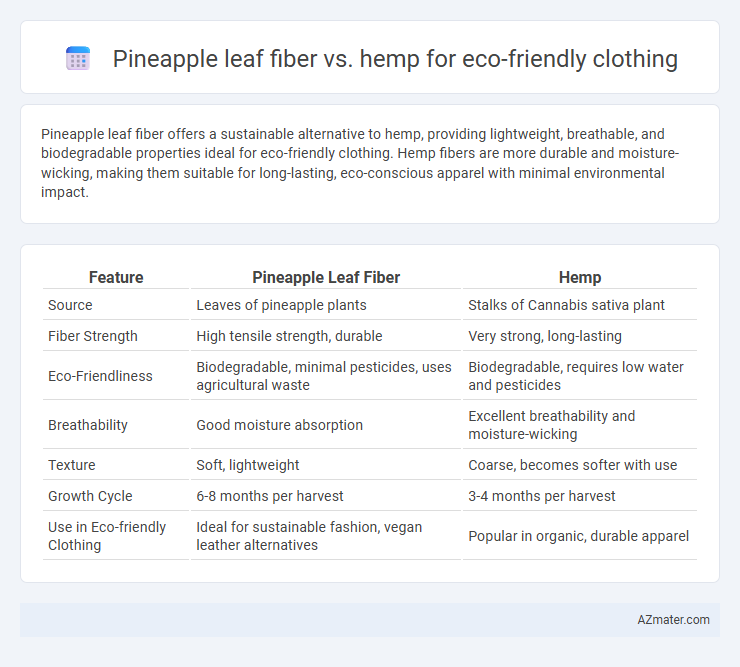Pineapple leaf fiber offers a sustainable alternative to hemp, providing lightweight, breathable, and biodegradable properties ideal for eco-friendly clothing. Hemp fibers are more durable and moisture-wicking, making them suitable for long-lasting, eco-conscious apparel with minimal environmental impact.
Table of Comparison
| Feature | Pineapple Leaf Fiber | Hemp |
|---|---|---|
| Source | Leaves of pineapple plants | Stalks of Cannabis sativa plant |
| Fiber Strength | High tensile strength, durable | Very strong, long-lasting |
| Eco-Friendliness | Biodegradable, minimal pesticides, uses agricultural waste | Biodegradable, requires low water and pesticides |
| Breathability | Good moisture absorption | Excellent breathability and moisture-wicking |
| Texture | Soft, lightweight | Coarse, becomes softer with use |
| Growth Cycle | 6-8 months per harvest | 3-4 months per harvest |
| Use in Eco-friendly Clothing | Ideal for sustainable fashion, vegan leather alternatives | Popular in organic, durable apparel |
Introduction to Eco-Friendly Clothing Materials
Pineapple leaf fiber and hemp both serve as sustainable alternatives in eco-friendly clothing materials due to their biodegradability and low environmental impact. Pineapple leaf fiber, derived from pineapple plant leaves, offers a soft texture and high tensile strength, making it suitable for lightweight fabrics. Hemp, known for its durability and resistance to pests, requires minimal water and no pesticides, contributing to its reputation as a highly sustainable textile option.
Overview of Pineapple Leaf Fiber
Pineapple leaf fiber, derived from the leaves of the pineapple plant, offers a sustainable and biodegradable alternative for eco-friendly clothing due to its high cellulose content and natural strength. This fiber is lightweight, breathable, and has excellent moisture-wicking properties, making it ideal for comfortable, durable textiles. Unlike hemp, pineapple leaf fiber production utilizes agricultural byproducts, reducing waste and promoting circular economy practices in the fashion industry.
Overview of Hemp Fiber
Hemp fiber is derived from the stalks of the Cannabis sativa plant and is renowned for its strength, durability, and biodegradability, making it a superior choice for eco-friendly clothing. It requires minimal pesticides and water during cultivation, significantly reducing environmental impact compared to conventional textiles. Hemp fabric also offers excellent breathability and UV resistance, enhancing wearer comfort and sustainability.
Environmental Impact: Pineapple Leaf Fiber vs. Hemp
Pineapple leaf fiber (PALF) and hemp are both sustainable materials with low environmental impact, but PALF uses agricultural waste from pineapple crops, reducing waste and minimizing land use, while hemp requires dedicated cultivation but grows rapidly with minimal pesticides and water. Hemp has a higher carbon sequestration potential due to its fast growth cycle, capturing more CO2 per hectare compared to pineapple plants. Both fibers biodegrade naturally, but PALF offers a superior eco-friendly option by valorizing agricultural byproducts and promoting circular economy practices in the textile industry.
Sustainability and Cultivation Practices
Pineapple leaf fiber and hemp both serve as sustainable options for eco-friendly clothing, with pineapples requiring no additional land since leaves are agricultural waste, enhancing zero-waste cultivation. Hemp grows rapidly, needs minimal pesticides, and replenishes soil nutrients, making it highly regenerative while yielding strong, durable fibers. Pineapple fiber production utilizes the leftover foliage from fruit farming, reducing environmental impact, whereas hemp cultivation contributes to carbon sequestration and soil health improvement.
Processing Methods and Energy Consumption
Pineapple leaf fiber involves degumming and mechanical extraction, requiring moderate water use and lower energy input compared to hemp, which undergoes retting, decortication, and scutching, processes typically more energy-intensive. Hemp processing consumes significant energy during decortication and fiber separation, but benefits from faster crop growth, reducing overall environmental impact. Both fibers offer sustainable alternatives, yet pineapple leaf fiber's less energy-intensive processing contributes to its appeal in eco-friendly clothing production.
Fabric Qualities: Texture, Strength, and Durability
Pineapple leaf fiber offers a soft, silky texture with a natural sheen, making it ideal for lightweight, breathable eco-friendly clothing, while hemp boasts a coarser feel but provides exceptional strength and durability, resisting wear and tear over time. Hemp fabric benefits from its toughness and moisture-wicking properties, ensuring long-lasting garments that maintain shape and integrity through frequent use. In comparison, pineapple leaf fiber excels in smoothness and luster but may require blending with stronger fibers to enhance durability for heavy-duty apparel.
Versatility and Applications in Fashion
Pineapple leaf fiber and hemp both excel in versatility for eco-friendly clothing, with hemp offering strong, durable fabric ideal for outerwear, denim, and casual wear due to its resistance to wear and moisture. Pineapple leaf fiber, known for its lightweight and silky texture, is favored in high-end fashion applications such as formalwear, accessories, and delicate garment details. Both fibers support sustainable fashion by providing renewable, biodegradable materials that cater to diverse design and functional needs across various clothing categories.
Market Availability and Cost Comparison
Pineapple leaf fiber, derived from agricultural waste, is gaining traction in eco-friendly clothing markets, especially in Southeast Asia, but its availability remains limited compared to hemp, which has a well-established global supply chain. Hemp fibers are generally more cost-effective due to large-scale cultivation and mature processing technologies, while pineapple leaf fiber tends to be pricier given its nascent production infrastructure. Brands adopting pineapple leaf fiber often emphasize its sustainability benefits despite higher costs, whereas hemp offers a balance of affordability and widespread accessibility for sustainable textile manufacturing.
Conclusion: Choosing the Right Eco-Friendly Fiber
Pineapple leaf fiber offers exceptional softness and breathability, making it ideal for lightweight, comfortable eco-friendly clothing, while hemp provides superior durability and natural antimicrobial properties suited for long-lasting garments. Choosing the right fiber depends on prioritizing fabric texture and breathability versus strength and longevity. Both fibers significantly reduce environmental impact by using renewable resources and requiring minimal pesticides, making them sustainable alternatives to conventional textiles.

Infographic: Pineapple leaf fiber vs Hemp for Eco-friendly clothing
 azmater.com
azmater.com